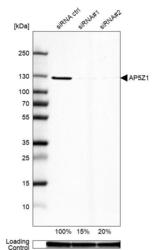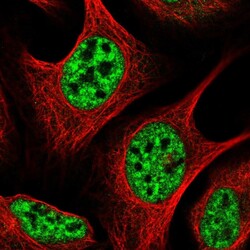Antibody data
- Antibody Data
- Antigen structure
- References [8]
- Comments [0]
- Validations
- Western blot [1]
- Immunocytochemistry [1]
Submit
Validation data
Reference
Comment
Report error
- Product number
- HPA035693 - Provider product page

- Provider
- Atlas Antibodies
- Proper citation
- Atlas Antibodies Cat#HPA035693, RRID:AB_10960687
- Product name
- Anti-AP5Z1
- Antibody type
- Polyclonal
- Description
- Polyclonal Antibody against Human AP5Z1, Gene description: adaptor-related protein complex 5, zeta 1 subunit, Alternative Gene Names: KIAA0415, SPG48, zeta, Validated applications: WB, IHC, ICC, Uniprot ID: O43299, Storage: Store at +4°C for short term storage. Long time storage is recommended at -20°C.
- Reactivity
- Human
- Host
- Rabbit
- Conjugate
- Unconjugated
- Isotype
- IgG
- Vial size
- 100 µl
- Concentration
- 0.2 mg/ml
- Storage
- Store at +4°C for short term storage. Long time storage is recommended at -20°C.
- Handling
- The antibody solution should be gently mixed before use.
Submitted references Spatacsin regulates directionality of lysosome trafficking by promoting the degradation of its partner AP5Z1
SPG15 protein deficits are at the crossroads between lysosomal abnormalities, altered lipid metabolism and synaptic dysfunction
Rag GTPases and phosphatidylinositol 3-phosphate mediate recruitment of the AP-5/SPG11/SPG15 complex
ArfGAP1 inhibits mTORC1 lysosomal localization and activation.
Role of the AP-5 adaptor protein complex in late endosome-to-Golgi retrieval
ZFYVE26/SPASTIZIN and SPG11/SPATACSIN mutations in hereditary spastic paraplegia types AR-SPG15 and AR-SPG11 have different effects on autophagy and endocytosis
Complicated spastic paraplegia in patients with AP5Z1 mutations (SPG48).
Loss of AP-5 results in accumulation of aberrant endolysosomes: defining a new type of lysosomal storage disease
Schuldiner M, Pierga A, Matusiak R, Cauhapé M, Branchu J, Danglot L, Boutry M, Darios F
PLOS Biology 2023;21(10):e3002337
PLOS Biology 2023;21(10):e3002337
SPG15 protein deficits are at the crossroads between lysosomal abnormalities, altered lipid metabolism and synaptic dysfunction
Marrone L, Marchi P, Webster C, Marroccella R, Coldicott I, Reynolds S, Alves-Cruzeiro J, Yang Z, Higginbottom A, Khundadze M, Shaw P, Hübner C, Livesey M, Azzouz M
Human Molecular Genetics 2022;31(16):2693-2710
Human Molecular Genetics 2022;31(16):2693-2710
Rag GTPases and phosphatidylinositol 3-phosphate mediate recruitment of the AP-5/SPG11/SPG15 complex
Hirst J, Hesketh G, Gingras A, Robinson M
Journal of Cell Biology 2021;220(2)
Journal of Cell Biology 2021;220(2)
ArfGAP1 inhibits mTORC1 lysosomal localization and activation.
Meng D, Yang Q, Melick CH, Park BC, Hsieh TS, Curukovic A, Jeong MH, Zhang J, James NG, Jewell JL
The EMBO journal 2021 Jun 15;40(12):e106412
The EMBO journal 2021 Jun 15;40(12):e106412
Role of the AP-5 adaptor protein complex in late endosome-to-Golgi retrieval
Schmid S, Hirst J, Itzhak D, Antrobus R, Borner G, Robinson M
PLOS Biology 2018;16(1):e2004411
PLOS Biology 2018;16(1):e2004411
ZFYVE26/SPASTIZIN and SPG11/SPATACSIN mutations in hereditary spastic paraplegia types AR-SPG15 and AR-SPG11 have different effects on autophagy and endocytosis
Vantaggiato C, Panzeri E, Castelli M, Citterio A, Arnoldi A, Santorelli F, Liguori R, Scarlato M, Musumeci O, Toscano A, Clementi E, Bassi M
Autophagy 2018;15(1):34-57
Autophagy 2018;15(1):34-57
Complicated spastic paraplegia in patients with AP5Z1 mutations (SPG48).
Hirst J, Madeo M, Smets K, Edgar JR, Schols L, Li J, Yarrow A, Deconinck T, Baets J, Van Aken E, De Bleecker J, Datiles MB 3rd, Roda RH, Liepert J, Züchner S, Mariotti C, De Jonghe P, Blackstone C, Kruer MC
Neurology. Genetics 2016 Oct;2(5):e98
Neurology. Genetics 2016 Oct;2(5):e98
Loss of AP-5 results in accumulation of aberrant endolysosomes: defining a new type of lysosomal storage disease
Hirst J, Edgar J, Esteves T, Darios F, Madeo M, Chang J, Roda R, Dürr A, Anheim M, Gellera C, Li J, Züchner S, Mariotti C, Stevanin G, Blackstone C, Kruer M, Robinson M
Human Molecular Genetics 2015;24(17):4984-4996
Human Molecular Genetics 2015;24(17):4984-4996
No comments: Submit comment
Enhanced validation
- Submitted by
- Atlas Antibodies (provider)
- Enhanced method
- Genetic validation
- Main image

- Experimental details
- Western blot analysis in U-87MG ATCC cells transfected with control siRNA, target specific siRNA probe #1 and #2, using Anti-AP5Z1 antibody. Remaining relative intensity is presented. Loading control: Anti-GAPDH.
- Sample type
- Human
- Protocol
- Protocol
Supportive validation
- Submitted by
- Atlas Antibodies (provider)
- Main image

- Experimental details
- Immunofluorescent staining of human cell line U-2 OS shows localization to nuclear speckles.
- Sample type
- Human
 Explore
Explore Validate
Validate Learn
Learn Western blot
Western blot Immunocytochemistry
Immunocytochemistry Immunohistochemistry
Immunohistochemistry